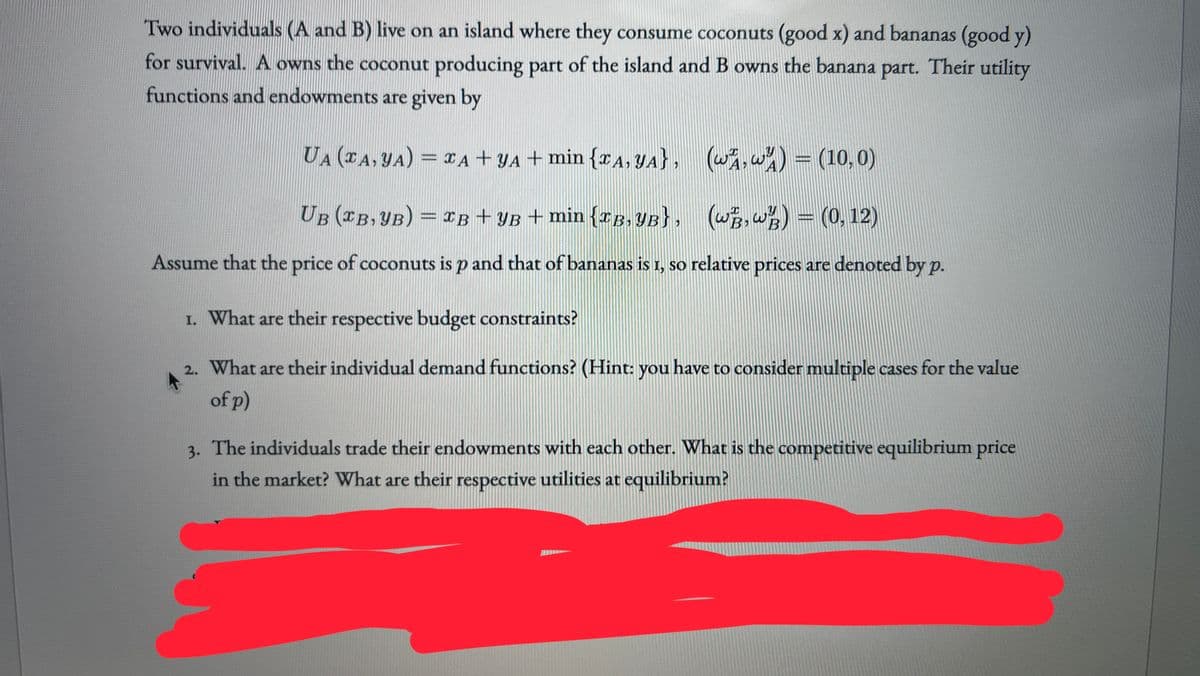Two individuals (A and B) live on an island where they consume coconuts (good x) and bananas (good y) for survival. A owns the coconut producing part of the island and B owns the banana part. Their utility functions and endowments are given by UA (CA, YA) = CA+YA +min {A, YA}, (w, w) = (10,0) UB (TB₁YB) = TB + YB + min {TB, YB}, (ww) = (0,12) Assume that the price of coconuts is p and that of bananas is 1, so relative prices are denoted by p. 1. What are their respective budget constraints? 2. What are their individual demand functions? (Hint: you have to consider multiple cases for the value of p) 3. The individuals trade their endowments with each other. What is the competitive equilibrium price
Two individuals (A and B) live on an island where they consume coconuts (good x) and bananas (good y) for survival. A owns the coconut producing part of the island and B owns the banana part. Their utility functions and endowments are given by UA (CA, YA) = CA+YA +min {A, YA}, (w, w) = (10,0) UB (TB₁YB) = TB + YB + min {TB, YB}, (ww) = (0,12) Assume that the price of coconuts is p and that of bananas is 1, so relative prices are denoted by p. 1. What are their respective budget constraints? 2. What are their individual demand functions? (Hint: you have to consider multiple cases for the value of p) 3. The individuals trade their endowments with each other. What is the competitive equilibrium price
Chapter13: General Equilibrium And Welfare
Section: Chapter Questions
Problem 13.5P
Related questions
Question

Transcribed Image Text:Two individuals (A and B) live on an island where they consume coconuts (good x) and bananas (good y)
for survival. A owns the coconut producing part of the island and B owns the banana part. Their utility
functions and endowments are given by
UA (TA,YA) = A+YA +min {A, YA},
UB (TB, YB) = TB +YB + min {ïß, YB},
(ww) = (0, 12)
B B
Assume that the price of coconuts is p and that of bananas is 1, so relative prices are denoted by p.
(ww) = (10,0)
A
1. What are their respective budget constraints?
2. What are their individual demand functions? (Hint: you have to consider multiple cases for the value
of p)
3. The individuals trade their endowments with each other. What is the competitive equilibrium price
in the market? What are their respective utilities at equilibrium?
Expert Solution
This question has been solved!
Explore an expertly crafted, step-by-step solution for a thorough understanding of key concepts.
This is a popular solution!
Trending now
This is a popular solution!
Step by step
Solved in 2 steps

Knowledge Booster
Learn more about
Need a deep-dive on the concept behind this application? Look no further. Learn more about this topic, economics and related others by exploring similar questions and additional content below.Recommended textbooks for you








